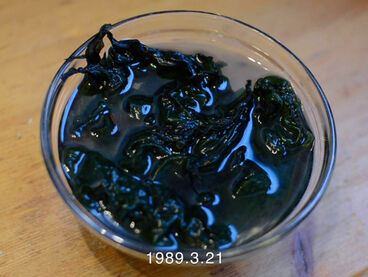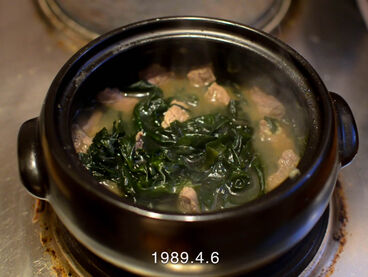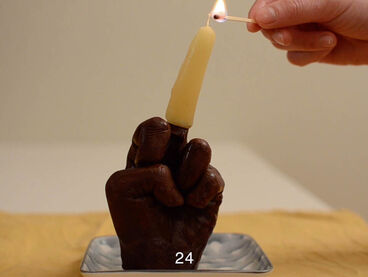MOOZ – audiovisual arts collection
How to cook Miyeokguk
2019, 3:54 min., color, sound, from Identities and Recipes, How to cook Miyeokguk
Concept and realization: Ji Su Kang-Gatto
Production: Academy of Media Arts Cologne
Birthday Soup: Emancipatory Cooking with Ji Su Kang-Gatto
How to cook Miyeokguk
The film How to cook Miyeokguk by Ji Su Kang-Gatto is a YouTube cooking tutorial, at least at first glance. While the title appears in this respect to be unambiguous and gives the impression that the video provides instructions for preparing this Korean seaweed soup, the first two seconds of the video dash the expectations of the viewers. We see a black leather armchair in front of a white radiator. There is a cut and now a young woman sits on the chair. She is wearing a red top and a red skirt. Both pieces of clothing have white polka dots on them. The young woman’s hair falls across her face, covering it. With the next cut, we see a bowl of dried seaweed being filled with water. Now as viewers we start to think we are in the midst of a cooking video, as what follows are close-up shots of various steps in the cooking process: seaweed is chopped, garlic is pressed, meat is marinated. Along with other ingredients, everything is added to a small pot and made into a soup, and, once cooked, the soup is ladled into a bowl and served with rice and other sides on a table. We wonder, is it a normal cooking tutorial?
The words delivered quietly and in monotone, which are spoken in Korean from off camera during the sequence of images and are probably from the protagonist we saw for a moment at the beginning of the video, could—based on the intonation—very well be conveying instructions for preparing the recipe. However, the English subtitles reveal that these utterances do not have anything to do at all with preparing soup. Evidently, the voice reads out the entries of a birth certificate—listing name, birth date, sex, date of registration, the person who made the registration as well as location and address. In the moment the entry for sex is mentioned, which is given as “female,” a shift appears at the visual level, and this documentation of a soup tutorial is interrupted with a quick cut back to the leather armchair from the beginning. Now we see how the protagonist sits on the right arm of the chair, in such a way that all we see is her red skirt and a hand.
The scene changes again and shows in a documentary close-up an empty pot into which oil is being poured. The preparation of the soup continues. After a time, the soup is done and is ladled into the bowl; here the view of the camera jumps once again back to the chair on which the protagonist is now laying crosswise on her back. Her head lies on the left arm and her legs are bent over the right arm of the chair; her arms are crossed. We only see half of her face, her eyes are outside of the frame. We can observe the even breath of the protagonist, then there is another jump cut. The soup is presented with sides on a tablecloth. In a series of quick edits, a dish of rice, plates with vegetables, and wooden cutlery appear one after another next to the bowl of soup. On another serving plate a sculptural object appears: a model of a clenched fist.
During this entire sequence, the voice from off camera begins to count to 30, saying the numbers 1 and 2 in Korean and then continuing in German. Only for the numbers 16 and 26 does she return to Korean. From the number 19 onward the camera focuses on the model of the fist, which turns out to be a kind of candleholder. A gap in the middle of the fist provides space for the protagonist to place a candle, which juts out like an outstretched middle finger. With number 24 the candle is lit. Between 28 and 29 the perspective changes again, the inner side of the fist no longer faces us, now we see the middle finger sticking up, with the gesture seemingly directed at the camera. The moment the number 30 is reached, the room goes dark and the flickering middle finger candle remains as the only light source. The voice from off camera says in Korean, “Happy birthday,” and in the next split second we see the protagonist blow out the candle, leaving behind a black screen. This ends the video.
The protagonist in How to cook Miyeokguk is the filmmaker Ji Su Kang-Gatto herself. This information is revealed as the name on the birth certificate that is read aloud in the video. The birth date in March 1989 that is also mentioned corresponds with the publishing date of the video on YouTube, it was uploaded to the site in March 2019, exactly 30 years later. The filmmaker therefore addresses the subject of her own birth with her supposed cooking tutorial, which is also suggested specifically by exploring the preparation of Miyeokguk. A quick look at Wikipedia tells us that this soup is not just the food recommended in Korea to eat after giving birth but is also often served on birthdays and is thus known as “birthday soup.” Through the deft contrast of visual cooking instructions and spoken information on her own background, Ji Su Kang-Gatto thus interrogates with How to cook Miyeokguk the meaning of her 30th birthday and implies a whole number of critical questions about her identity and the circumstances around it. While the genre of cooking tutorial chosen by her implies a strictly controlled and predefined process with an explicit goal, i.e., the proper preparation of a traditional soup, against the backdrop of the birth certificate being read aloud, she confronts us as viewers inevitably with the question of whether it might play out the same way with a person’s path through life, and in what sense do such parallels result here: Do the entries on a birth certificate have the same function as the listing of different ingredients in a recipe? Do they map out our path in life and our life goals exactly like cooking instructions define the preparation of a dish? What effect, for example, does the place of birth have on the course of one’s life? What results from being assigned a particular gender? How do the underlying starting parameters change over the course of time and how much influence do we have on what results from the combination of various determiners, or rather various “ingredients”? Do we have to stick to the recipe parameters? How do we feel about traditions, and are there alternatives to predefined deadlines?
Through counting from 1 to 30 Ji Su Kang-Gatto integrates her own life chronology at the acoustic level of the video and evokes thus a (self-)reflection on her life from her birth in 1989 to her 30th birthday. We follow along with her through each individual year of life and ask ourselves to what extent each of the images we see might give us hints about specific life events. With number 1, the soup pot is uncovered, making an almost too obvious visual correlation to birth and the start of the first year of life, which invites us in its metaphoric apparentness to also search out corresponding visual meaning in the following numbers. Thus, we ask, for example, why she counts in German from number 3 onward. Did the filmmaker perhaps come to Germany in this year of life and have her first contact with the language then? Why do we see her lying on the chair from 9 to 12? Does she connect particular memories to this time? Why is the number 16 said in Korean, and is there any significance in that just as she says 18 the camera pans to the fist sculpture? Why is the candle lit at 24? Why is the number 26 said in Korean? And for whom exactly is this middle finger meant, which is turned to face the camera between 28 and 29? What events, what biographical developments, and what formative happenings are concealed behind all these numbers and visuals?
The filmmaker does not provide concrete answers to these questions. However, in a manner that is conceptually extremely reduced, she succeeds in her video to imbue in this more documentary-style genre of cooking tutorial the nuances of a coming-of-age story, which finds its high point in the quasi-rebellious gesture at the end of the video. How to cook Miyeokguk culminates with a payoff that, especially by virtue of its minimalistic staging, is shaped by the gesture of the humoresque and clearly breaks with the expectations of the viewers: the last thing one anticipates at the end of a cooking video is the insulting connotation of the middle finger gesture. While the counting from 1 to 30 still conveys a coherent and predictable (life) progression, the middle finger appears at the end as a direct intervention, which the protagonist uses to distance herself from both the bureaucratically predetermined entries on the birth certificate as well as the established steps in preparing a soup. From a retrospective view, i.e., from the point in time of the 30th birthday looking back, she questions both lines of development—that of her own life and that of the “birthday soup”—and turns away from both. Thus, the video generates an emancipatory moment that accepts neither official records nor culinary traditions as codified certainties and, in fact, counters them with her power of agency in the form of the symbolism of resistance.
Here on this outstretched middle finger a discussion is ignited, in the true sense of the word, around assigning certain meanings to things that shape our lives from birth onward. Whether in relation to categories like our background, our gender, or our age: what are derived from these are identity attributes that have a massive influence on the course of our lives, although they are usually based on purely arbitrary or at least merely contingent characteristics. How to cook Miyeokguk subtly rebels against such attributions and encourages countering them with self-defined perceptions and personal desires. Exactly how the resulting life plans look remains fittingly completely individual and different from person to person. In this respect, it is only consistent that by the end of the video no explicit directives have been given, like we perhaps might have expected from a conventional cooking tutorial. But there is simply no one-size-fits-all recipe for a life, or life in general, and so logically, we see ourselves confronted with more questions than answers before the light goes out at the end of this multilayered film. One of these questions could again relate to the filmmaker herself: What perhaps does Ji Su Kang-Gatto wish for her life, as she blows out this very meaningfully symbolic candle, leaving us in the dark?
Text - Konstantin Butz
Ji Su Kang-Gatto (born 1989) completed her studies at the Kunstakademie Düsseldorf in 2013 as a master student of Lucy McKenzie. She finished her postgraduate studies at the Academy of Media Arts Cologne in summer 2021 with her work Vlog 8998, supervised by Prof. Matthias Müller, Daniel Burkhardt, and Prof. Dr. Lilian Haberer.
Her works have been shown in numerous exhibition spaces and film festivals, including the São Paulo International Short Film Festival and the IMAI Foundation at the NRW-Forum in Düsseldorf. Kang-Gatto received a painting scholarship from the Kunstakademie Düsseldorf and a work scholarship in South Korea funded by the Kunststiftung NRW. The category “Experiment” at the 31st São Paulo International Short Film Festival was dedicated to her work series Identities and Recipes.
As the director of Identities and Recipes, she was also part of the Official Selection / Aviff Cannes Art Film Festival in 2021 and won Third Prize.
Episode 4 – selected by Ji Su Kang-Gatto was recently on exhibit (until October 27, 2021) at the NRW-Forum Düsseldorf as part of the IMAI Foundation.
















